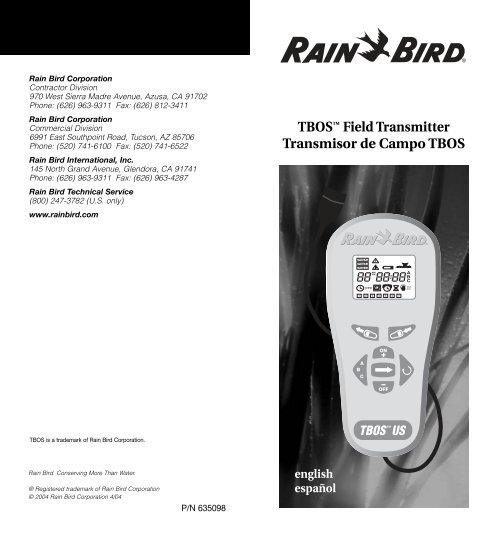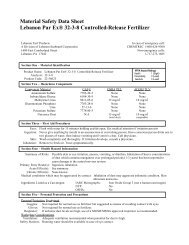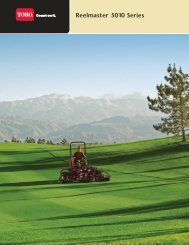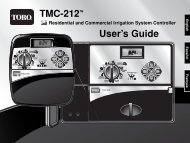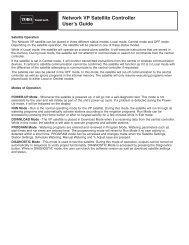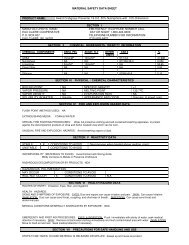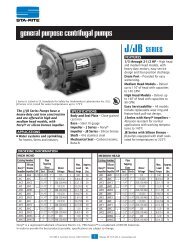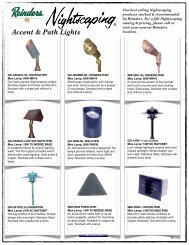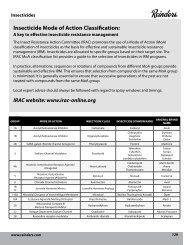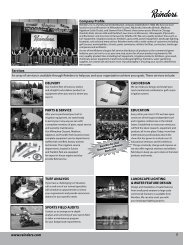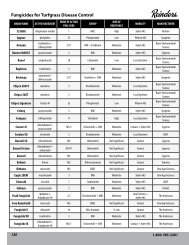Print TBOS manual (ENG/sp) - Rain Bird
Print TBOS manual (ENG/sp) - Rain Bird
Print TBOS manual (ENG/sp) - Rain Bird
- No tags were found...
Create successful ePaper yourself
Turn your PDF publications into a flip-book with our unique Google optimized e-Paper software.
<strong>Rain</strong> <strong>Bird</strong> CorporationContractor Division970 West Sierra Madre Avenue, Azusa, CA 91702Phone: (626) 963-9311 Fax: (626) 812-3411<strong>Rain</strong> <strong>Bird</strong> CorporationCommercial Division6991 East Southpoint Road, Tucson, AZ 85706Phone: (520) 741-6100 Fax: (520) 741-6522<strong>Rain</strong> <strong>Bird</strong> International, Inc.145 North Grand Avenue, Glendora, CA 91741Phone: (626) 963-9311 Fax: (626) 963-4287<strong>Rain</strong> <strong>Bird</strong> Technical Service(800) 247-3782 (U.S. only)www.rainbird.com<strong>TBOS</strong> Field TransmitterTransmisor de Campo <strong>TBOS</strong><strong>TBOS</strong> is a trademark of <strong>Rain</strong> <strong>Bird</strong> Corporation.<strong>Rain</strong> <strong>Bird</strong>. Conserving More Than Water.® Registered trademark of <strong>Rain</strong> <strong>Bird</strong> Corporation© 2004 <strong>Rain</strong> <strong>Bird</strong> Corporation 4/04P/N 635098englishe<strong>sp</strong>añol
english<strong>TBOS</strong> Field TransmitterenglishOperating principleAbove parameters are transmittedto the module.The above parameters are receivedby the transmitter.Programtransmission• Current timeand day• Water days/program• Start times/program• Run time/station +programassignmentProgramreception/di<strong>sp</strong>lay• Water days/program• Start times/program• Run time/station +programassignment• IrrigationmodeON or OFFNOTE: The transmitter does not receive the currenttime from the module: there may be a difference in thecurrent time between the transmitter and the module.It is therefore advisable to retransmit the program tothe module to synchronize the current time in themodule with your transmitter.Welcome to <strong>Rain</strong> <strong>Bird</strong>The <strong>TBOS</strong> Field Transmitter, part of the <strong>TBOS</strong>irrigation system family, allows you to create,transmit and retrieve irrigation programminginformation when used with the <strong>TBOS</strong> orUNIK Control Module.The Field Transmitter features include:• One minute to 12 hour irrigation run times perstation in one minute increments• Three independent programs: A, B, C• Up to eight start times per program per day• 365-day calendar (adjusts for leap year)• Standard mode: 7-day (custom) cycle; any daycan be set ON or OFF as a watering day• Turbo mode: includes 7-day (custom) cycle plusthe following cycles:• Even day, odd day or odd-with-31st-of-themonth-offcycles (adjusts for leap year)• 1 through 6 day cycles, water one of every oneto six days• Manual irrigation start or stop capacity• Low battery icon indicates when a new battery isneeded in the <strong>TBOS</strong> Field Transmitter or <strong>TBOS</strong>Control Modules• Ability to program an unlimited number of UNIKand <strong>TBOS</strong> Control Modules with one FieldTransmitter• Automatic reset of current time and day whentransmitting a program to a Control Module1
english<strong>TBOS</strong> Field TransmitterenglishQuick Programming GuideA Quick Programming Guide label is providedwith the Field Transmitter. This label should beplaced on the inside of the Field Transmitter’<strong>sp</strong>rotective cover.Understanding the MenuDi<strong>sp</strong>lay, Icons and KeypadMenu systemThe Field Transmitter has a cyclical menu system,which means that you move through theeight menu di<strong>sp</strong>lays one di<strong>sp</strong>lay at a time bypressing B. All of the di<strong>sp</strong>lays (except thestart-up di<strong>sp</strong>lay) have icons representing thefunction that you can program while in thatdi<strong>sp</strong>lay.LCD di<strong>sp</strong>lay icons113 12 11108. Manual start:• single station: STA• multi-station (cycle): CYC9. Assign a station to a program (A, B, or C)10. On-off mode11. Low battery indicator12. Transmitting program13. Transmission failedKeypadABCDEFG231. Program (A, B, or C)2. Current time3. Day of week or water day4. Select water cycle5. Set watering days6. Start time7. Run time for each station4 5 6 7 89A. Transmit (download program) to Control ModuleB. Increase/OnC. Program (A, B, C)D. Arrow key/Next functionE. Decrease/OffF. Retrieve (upload program) from Control Moduleand di<strong>sp</strong>lay programG. Cycle key• set clock/set current day• watering time per station/select station• start times/move to next start time• select standard or custom cycles in Turbomode23
english<strong>TBOS</strong> Field TransmitterenglishInstalling the BatteryThe Field Transmitter is powered by a 9-voltalkaline battery (not included), type 6AM6(international standard) or type 6LR61(European standard). We recommend that youuse a high-quality alkaline battery, such asEnergizer. A high-quality battery will last oneyear.To install the battery:1. Remove the screws that secure the battery compartmentcover.2. Remove the battery connector from the batterycompartment and attach the battery to the connector.3. Insert the battery and connector into the batterycompartment.When the battery is properlyconnected, the start-up di<strong>sp</strong>layappears as shown.4. Reinstall the screws that securethe battery compartment cover.The Field Transmitter can now be programmed.Setting up the FieldTransmitterBefore you can create watering programs, youmust select the time format set the current dateand timeSelecting the time format:1. Select either a 12-hour or a 24-hour di<strong>sp</strong>lay. Thedefault time di<strong>sp</strong>lay is 24 hour. If you would likea 12-hour di<strong>sp</strong>lay, press O . The words AM PMwill appear in the di<strong>sp</strong>lay.2. Press B to move to setting the year.4Setting the current date (year, month and day):1. Press O or P to set the current year.2. Press B to move to setting the month and day.3. If the time is di<strong>sp</strong>layed in the 24 hour format, thelast two digits will be blinking. If the time is di<strong>sp</strong>layedin the 12 hour format, the first two digitswill be blinking. The blinking digits represent themonth. Set the month by pressing O orP .Press B to move to the day. Set the day bypressing O orP .4. Press B to move to setting the time.Changing the current date (year, month andday):1. Turn on the Field Transmitter. If the FieldTransmitter is already on, press B to advanceto the startup di<strong>sp</strong>lay (the screen di<strong>sp</strong>laying thecurrent time and day of the week).2. Press and hold B until the year is di<strong>sp</strong>layed onthe screen.3. Follow the steps for setting the current date listedabove.Setting the timeThis screen shows the currenttime and current day(1 = Monday, 2 =Tuesday…7 = Sunday).To set the time:1. Press B until D appears in the di<strong>sp</strong>lay.2. To switch between 12-hour and 24-hour di<strong>sp</strong>lay,press and hold downAfor two seconds.3. Press O to advance the clock orPto reversethe clock. Pressing and holding down either keywill make the numbers change more quickly.5
english<strong>TBOS</strong> Field TransmitterenglishNote: If the di<strong>sp</strong>lay shows AM and thecurrent time is actually PM, advance orreverse the clock until the di<strong>sp</strong>layshows PM.Important: When you change the batteriesin the Field Transmitter, the timereverts back to the 24-hour di<strong>sp</strong>lay.Programming the FieldTransmitterBefore you begin programming the Field Transmitter,please take some time to learn some of theprogramming and connection options you have withyour irrigation system.Three independent programsThe Field Transmitter has three programs:A, B and C. This allows you to select a programaccording to plant type; for example,A for grasses, B for shrubs and C for trees. Stationsassigned to the same program operate sequentially.For seven day cycles, these are independent programs.You can consider each program as a separatecontroller with its own water days, start times andrun times.For odd, even or 1 through 6 day cycles, all programsuse the same water days but start times andrun times may be programmed independently foreach program.Note: A station may be assigned to onlyone program, either A, B or C.Simultaneous watering startIf you assign a separate or different station to eachprogram with the same water days, start times andrun times, you will obtain an almost simultaneousstart of all three stations.6Multiple stations and programsIf you want more than eight start times per day on asite equipped with only one valve, you can wire thevalve to several stations on a Two, Four, or Six StationControl Module and program multiple start timesfor each station.For example, if you wire the same valve to both stationson a Two Station Control Module, you canobtain up to 16 starts (2 x 8). If you connect the samevalve to three stations on a Four Station ControlModule, you can obtain up to 24 starts (3 x 8).Stations assigned to this valve, however, cannot beassigned to other valves. If you use this method,make sure that there is no program overlap. The programrun time must be shorter than the time intervalseparating the two start times.Note: A One Station Control Modulecan use only one program.Now you can begin setting up your watering cycles.Standard and Turbo modesThe <strong>TBOS</strong> Field Transmitter has two modes of operation:Standard and Turbo.The Standard mode of operation is identical to theUNIK Field Transmitter. This mode offers only the 7-day cycle and is useful when only 7-day (custom)cycles are needed or when using the <strong>TBOS</strong> FieldTransmitter to program UNIK Control Modules.Note: Standard mode is the defaultmode of operation.The Turbo mode offers even day, odd day and odd-31 (odd days with the 31st of the month) cycles and1 through 6 day cycles for use with <strong>TBOS</strong> ControlModules.7
english<strong>TBOS</strong> Field TransmitterenglishSwitching between Standard and TurbomodesTo switch between modes, press the B andPkeys simultaneously. The di<strong>sp</strong>lay will show “std” or“turbo” for three seconds to indicate which mode isnow set.Important: When you change the batteriesin the Field Transmitter, the unitreturns to Standard mode.Setting the water cycle (Turbo mode only)1. Press B until the CYC F icon appears. PressCto advance through the following choices:• 7-day cycle (a different watering day schedulemay be programmed for each program, A, Band C.• Even day watering (“Even”) for all three programs,A, B and C.• Odd day without the 31st day watering (“Odd”)for all three programs, A, B and C.• Odd day with the 31st day watering (“31 Odd”)for all three programs, A, B and C.• 1 through 6 day cycles, water one of every one tosix days.2. Select the watering cycle by pressing C andstopping at the desired watering cycle. PressB to set the selected watering cycle and movetoF, setting the watering days.8Important: If you attempt to transmit anEven, Odd or 1 through 6 day wateringcycle to a UNIKControl Module, theW will appear in thedi<strong>sp</strong>lay and you willhear a ringing sound.Then an error screenwill appear:Setting the water daysTo set the watering days:7-day cycle1. Watering days for sevenday cycles are selectableper program.Select the desiredprogram by pressingtheA key.2. If you do not want to water on a certain day thatis set as a watering day (it has a square aroundit), pressCrepeatedly to advance to that day.The day selected will blink.3. Press P to remove the square. The square willdisappear and no watering will occur on theselected day.4. If a day you want to water does not have a squarearound it, pressCrepeatedly to advance to thatday.The day selected will blink.5. Press O to place a square around the day.A square will appear around the day and wateringwill take place on the selected day.6. Repeat steps 2-5 until all the days are set for theprogram. When you are ready to move on to the9
english<strong>TBOS</strong> Field Transmitterenglishnext program, pressAto change to anotherprogram.7. When you have set the watering days for all ofyour programs, press B to move to the Gicon, Setting the Start Times di<strong>sp</strong>lay.Even day cycle1. The watering days are setfor even days.2. Press B to move to, setting the start times.GOdd day cycle with 31stday off1. The watering days are setfor odd days with the 31stday off.2. Press B to move to G ,setting the start times.Odd day cycle with 31stday on1. The watering days are setfor odd days with the 31stday on.2. Press B to move to G ,setting the start times.1 through 6 day cycles1. Watering days for 1 through 6 day cycles are thesame for all three programs.2. Press C to select the daycycle from 1 to 6 days. Forexample, to select a 6-daycycle, pressCuntil sixdays are di<strong>sp</strong>layed on thebottom of the screen.103. Press B to move to setting “today” in thewatering cycle.4. If you selected a 1 to 6 day watering cycle, therow of days in that cycle appears in the di<strong>sp</strong>laywith a box around day 1. The only watering dayin a 1 to 6 day cycle is day 1.5. A number appears in the di<strong>sp</strong>lay, indicatingwhere “today” is in the watering cycle.6. Press O or P to move today’s position inthe watering cycle.7. For example, if you set “today” as day 2 in a 3-daycycle, the next watering day in the cycle will bethe day after tomorrow, since tomorrow wouldbe day 3, followed by day 1, the watering day.8. Press B to move to G, setting the starttimes.Setting the start timesYou can set up to eight start times for each program,but it is not necessary for you to use all eight starttimes with each program. After you enter all the starttimes, the transmitter will automatically organizethe start times in chronological order, from 00:00 to23:59 or 12:00 AM to 11:59 PM.To set the start time:1. Make certain theGicon is visible on the di<strong>sp</strong>lay.If it is not, press B repeatedly to cyclethrough the menu system and di<strong>sp</strong>lay theGicon.2. Press A repeatedly until the program you desire(A, B, or C) appears in the di<strong>sp</strong>lay.3. Use O and P to set the first start time.4. PressCto move to the next start time.(continued)11
english<strong>TBOS</strong> Field Transmitterenglish5. Repeat steps 3 and 4 until you have set all of thestart times you desire (up to eight per program)for the program.6. If you would like to set start times for additionalprograms, pressAuntil the program you desireis di<strong>sp</strong>layed. Then repeat steps 3 and 4.7. When you have finished setting the start times,press B to move to theHicon, Setting theWatering Time Length di<strong>sp</strong>lay.Deleting a start timeTo delete a start time:1. Press B to advance to the G icon.2. PressAto change to the appropriate program.3. PressCto scroll through the start times untilthe start time you want to delete is di<strong>sp</strong>layed.(The start times will be in chronological order).4. Press Oor Puntil the blank position(--:--) appears in the di<strong>sp</strong>lay. The blank positionis located between 11:59 and 12:00 (AM or PM).5. PressCto scroll through the remaining starttimes and confirm the deletion.Setting the run time per stationYou can set the run time for each station from 0 to 12hours (in one minute increments). All One StationControl Modules must be programmed on station 1.Multi-station Control Modules (Two, Four, or SixStation) must be programmed starting on station 1.For example, on a Four Station Control Module, programmingwould start on station 1, then station 2, 3and 4.Note: Each station may be assigned toonly one program (A, B or C)! The stationwill only re<strong>sp</strong>ond to the start timesand days on for this program.12Note: The time di<strong>sp</strong>lay is represented inhours and minutes. The first two placeholdersare for hours; the second twoplaceholders are for minutes.To set the run time:1. Make certain the H icon isvisible on the di<strong>sp</strong>lay. If it isnot, press B repeatedlyto cycle through the menusystem and di<strong>sp</strong>lay the Hicon.2. The station number appears to the left of the runtime. UseCto select the station.3. Press A repeatedly until the program you desire(A, B, or C) flashes in the di<strong>sp</strong>lay (to the right ofthe run time). Each station must be assigned to aprogram (A, B, or C).4. Use OandPto set the station run time.5. PressCto move to the next station.6. Repeat steps 3 through 5 until you have set all ofthe station run times.Note: If there is an overlap on the samestation, the second run time will nottake place.7. When you have finished setting the run times,you may review the run times by pressingC .Erasing Field Transmitter programming dataTo erase all program data in the Field Transmitter(except the current time and day):Press and hold OandPsimultaneouslyfor atleast three seconds.All programming data are erased.13
english<strong>TBOS</strong> Field TransmitterenglishTransmitting Programs to aControl ModuleWhen you want to transmit (download) programdata to a Control Module:1. If the Field Transmitter’s di<strong>sp</strong>lay is blank,press B .2. If you have not already done so, enter the programdata into the Field Transmitter.3. Plug the FieldTransmitter’s opticalconnector onto theControl Module’soptical connector.4. PressR .The W icon will appear on the screen for two seconds.When the icon disappears from the di<strong>sp</strong>lay, theprogram data has been successfully transmitted.Important: If there is a transmissionproblem, the W icon will appear in thedi<strong>sp</strong>lay and you will hear three beeps.Then the E icon will appear.Verify that the:• Field Transmitter and the Control Module areconnected properly• Field Transmitter’s and Control Module’s opticalconnectors are clean (wipe the connectors with adamp cloth)• Field Transmitter and Control Module have afully charged 9-volt alkaline battery• Press B and then transmit the programminginformation again.145. Disconnect the Field Transmitter from theControl Module.Reviewing Control Module programsWhen you want to verify the program data of aControl Module:1. Plug the Field Transmitter’s optical connectoronto the Control Module’s optical connector.2. If the Field Transmitter’s di<strong>sp</strong>lay is blank,press B .3. Press Ton the Field Transmitter to receive(upload) the program data stored in the ControlModule. You can now review all of the ControlModule program data except the current time ofday stored in the Control Module.Note: The Field Transmitter does notreceive the current time from theControl Module because there may bea difference in the current time betweenthe two devices. However, when youtransmit (download) a program to aControl Module, the Field Transmittersynchronizes the Control Module’s currenttime with the Field Transmitter’scurrent time.Note: if a <strong>TBOS</strong> Field Transmitter set inStandard mode receives a Turbo modeprogram from a <strong>TBOS</strong> Control Module,the Field Transmitter will automaticallyswitch to Turbo mode and the di<strong>sp</strong>laywill show “turbo” for three seconds.4. To modify the program data stored in the ControlModule, enter the desired modifications into theField Transmitter, then press R to transmit(download) the program to the Control Module.15
english<strong>TBOS</strong> Field TransmitterenglishThe W icon will appear on the screen for twoseconds. When the icon disappears from the di<strong>sp</strong>lay,the program data has been successfullytransmitted.Note: Press R even if you have notmade any changes to the programmingdata. This will synchronize the timebetween the two devices.On-off Mode/System OverrideThe Field Transmitter’s On-off function allows you tocompletely su<strong>sp</strong>end and override all currently setprogramming in the Control Module, withoutchanging or losing this programming for future use.The Control Module’s default mode is always ON,allowing programmed watering to take place. Youcan prevent watering, however, by activating the OnoffMode, thereby switching the Control Module’sdefault mode to OFF.Activating a Control Module’s On-off ModeTo activate the On-off Mode (or turn the ControlModule’s default mode to OFF):1. Press B on the Field Transmitter repeatedlyuntil theicon is di<strong>sp</strong>layed.• If the On-off Mode is deactivated, you will see theicon, indicating that the ControlModule will water according to current programming.• If the On-off Mode is activated, you will see theicon, indicating that all ControlModule programs have been overridden and nowatering will take place.162. If the icon is di<strong>sp</strong>layed, pressP .The Field Transmitter sends the irrigation OFFcommand to the Control Module. An X willappear on the <strong>sp</strong>rinkler icon .Deactivating a Control Module’s On-off ModeTo deactivate the On-off Mode (or turn the ControlModule’s default mode on):1. Press B on the Field Transmitter repeatedlyuntil theicon is di<strong>sp</strong>layed.• If the On-off Mode is deactivated, you will see theicon, indicating that the ControlModule will water according to current programming.• If the On-off Mode is activated, you will see theicon, indicating that all ControlModule programs have been overridden and nowatering will take place.2. If the icon is di<strong>sp</strong>layed, press O.The Field Transmitter sends the irrigation ONcommand to the Control Module. The X on the<strong>sp</strong>rinkler icon disappears .Verifying the On-off ModeTo check the Control Module’s On-off status:1. Plug the Field Transmitter’s optical connectorinto the Control Module’s optical connector.2. If the Field Transmitter’s di<strong>sp</strong>lay is blank,press B .3. Press Ton the Field Transmitter to receive(upload) the program data stored in the ControlModule.4. Press B on the Field Transmitter repeatedlyuntil theicon is di<strong>sp</strong>layed.(continued)17
english<strong>TBOS</strong> Field Transmitterenglish• If the On-off Mode is deactivated, you will see theicon, indicating that the ControlModule will water according to current programming.• If the On-off Mode is activated, you will see theicon, indicating that all ControlModule programs have been overridden and nowatering will take place.Performing Manual Startsand StopsImportant: Before you perform <strong>manual</strong>starts and stops, you must verify theControl Module’s irrigation status. SeeVerifying the On-off Mode, above.Note: The <strong>manual</strong> functions describedbelow override all other functions(except On-off); any program currentlyrunning will be su<strong>sp</strong>ended to permittheir use. Manual starts and stops onlyaffect an existing station run time orprogram.Important: Manual operations will notwork if the On-off Mode is activated.Starting a Control ModuleManuallyYou can perform either a single-station or a cycle(multi-station) <strong>manual</strong> start. Before carrying outeither type of <strong>manual</strong> start, make sure you have programmeda run time of at least one minute per stationand that the Control Module’s On-off Mode isnot activated.18Performing a <strong>manual</strong> single-station startIf you would like to <strong>manual</strong>lystart one station:1. Press B until the Nicon is di<strong>sp</strong>layed.The station numberwill also bedi<strong>sp</strong>layed.2. Press P to stop any stations that may bewatering. If a station is in operation, a <strong>manual</strong>start is impossible. A station may be in operationat the module level, but without any irrigation inthe field. This is what occurs when the <strong>Rain</strong> ShutoffDevice prevents programmed irrigation.3. Press C until the station you would like to startis di<strong>sp</strong>layed.4. To start a station, press O . Irrigation will startwithin a few seconds.5. If you wish to stop watering before the programmedtime is up, pressP .Performing a <strong>manual</strong> cycle startThe cycle consists of all of theprogrammed stations operatingin sequential order.To <strong>manual</strong>ly performa cycle start:1. Press B until the M icon is di<strong>sp</strong>layed.Prog A, B or C also appears in the di<strong>sp</strong>lay.2. Press P to stop any stations that may bewatering. If a station is in operation, a <strong>manual</strong>start is impossible. A station may be in operationat the module level, but without any irrigation in19
english<strong>TBOS</strong> Field Transmitterenglishthe field. This is what occurs when the <strong>Rain</strong> ShutoffDevice prevents programmed irrigation.3. Press A until the program cycle you would liketo start is di<strong>sp</strong>layed.4. Press O to start the cycle.Irrigation will start within a few seconds. Thestations assigned to the program will operate insequence until the last station has finishedwatering. Irrigation will then stop.5. If you wish to stop watering before the <strong>manual</strong>cycle has completed, pressP .Low Battery Indicator<strong>TBOS</strong> Field Transmitter1. When the <strong>TBOS</strong> FieldTransmitter is turned on,the battery icon will blinkfor 30 seconds if the <strong>TBOS</strong>Field Transmitter battery islow. The Field Transmitterwill then shut off automatically.You should replace the Field Transmitter’sbattery immediately.<strong>TBOS</strong> Control Module1. When data is uploaded(retrieved) from or downloaded(sent) to the <strong>TBOS</strong>Control Module, the batteryicon will be di<strong>sp</strong>layed onthe Field Transmitter if theControl Module battery is low. The icon will disappearif B is pressed. You should replace theControl Module’s battery immediately.Important: The Control Module low batteryindicator will function only with<strong>TBOS</strong> Control Modules, not with UNIKControl Modules.Maintaining the <strong>TBOS</strong> FieldTransmitterTo keep your Field Transmitter in working order:• Change the battery once a year. We recommendyou use a high-quality alkaline battery, such asEnergizer. When changing the Field Transmitterbattery, any stored programs will be lost. To avoidthis:1. Press R to download the programs into aControl Module.2. Change the battery.3. Press T to upload the programs into theField Transmitter.• Replace the Field Transmitter’s protective coverafter use.• Secure the optical connector to the base of thecord after use.• Do not expose the liquid crystal di<strong>sp</strong>lay (LCD) tosunlight for prolonged periods.2021
english<strong>TBOS</strong> Field Transmitterenglish<strong>TBOS</strong> and UNIK CompatibilityField transmitter:Control ModuleTurbo mode: 7-day (custom)cycle plus Even, Odd, Odd-31and 1 through 6 day cyclesLow battery icon indicateswhen a new battery is neededin the Control ModuleLow battery icon indicateswhen a new battery is neededin the Field TransmitterSimple deletion of start timesReplaceable Field Transmittercord365-day calendar (adjusts forleap year)One minute to 12 hour irrigationrun times per station inone minute incrementsThree independent programs:A, B, CUp to eight start times perprogram per day7-day (custom) cycle; any daycan be set ON or OFF as awatering dayManual irrigation start or stopcapacityAbility to program an unlimitednumber of UNIK and <strong>TBOS</strong>Control Modules with oneField TransmitterAutomatic reset of currenttime and day when transmittinga program to a ControlModuleOn-off mode (watering override)UNIK UNIK <strong>TBOS</strong> <strong>TBOS</strong>UNIK <strong>TBOS</strong> UNIK <strong>TBOS</strong>✔22✔✔✔✔✔✔✔✔✔✔ ✔ ✔ ✔✔ ✔ ✔ ✔✔ ✔ ✔ ✔✔ ✔ ✔ ✔✔ ✔ ✔ ✔✔ ✔ ✔ ✔✔ ✔ ✔ ✔✔ ✔ ✔ ✔TroubleshootingThe following list contains possible problems youmay encounter and some solutions.Most of the problems involving the <strong>TBOS</strong> FieldTransmitter can be classified as transmission/ receptionmalfunctions usually caused by a dead orimproperly connected battery. Other common causesof malfunction could be a dirty optical connectorand poor wire connections.These problems are easy to fix. If you experiencetransmission/reception problems, try using aControl Module that operates properly to determineif it is the Field Transmitter or Control Module that isthe source of the problem.Before calling <strong>Rain</strong> <strong>Bird</strong>, check this list. If you cannotsolve the problem yourself, call our Technical ServiceHotline at 1-800-247-3782 (U.S.) or 626-963-9311(outside the U.S.) and we will be glad to help you.Problem: Weak LCD di<strong>sp</strong>lay/nodi<strong>sp</strong>lay/incomplete di<strong>sp</strong>layPossible cause: The battery is weak.Solution: Replace the battery.Possible cause:Solution:Possible cause:Solution:The microprocessor has locked up.Remove the battery. Short the <strong>TBOS</strong>Field Transmitter battery clip (notthe battery) contacts together with apaper clip or other piece of metalfor 30 seconds. Reinstall a fresh battery.The battery contact is faulty.Tighten the battery connectors toensure tight battery connection.23
english<strong>TBOS</strong> Field TransmitterenglishProblem:Possible cause:Solution:Problem:Possible cause:Solution:Possible cause:Solution:Possible cause:Solution:Possible cause:Solution:Locked di<strong>sp</strong>lay or keypadThe microprocessor did not resetproperly.Remove the battery. Short the <strong>TBOS</strong>Field Transmitter battery clip (notthe battery) contacts together with apaper clip or other piece of metalfor 30 seconds. Reinstall a fresh battery.Station does not startNo run time has been programmedfor that station.Transmit a run time to the ControlModule.The On-off Mode is activated (X onSprinkler icon ).Permit irrigation by deactivating theOn-off Mode.Another station is in operation.Use the <strong>manual</strong> station option toturn off that station.The battery is weak.Replace the battery.Possible cause:Solution:If you are using 3M DBM wire connectors,make sure the wires havenot been stripped. Unlike other wireconnectors on the market, DBMsare designed to cut through theinsulation to make a water-resistantcoupling without removing theinsulation. Push the wires all theway into the wire connector. Be sureto crimp the black cap all the waydown (gel should ooze out of thetop) to ensure a water resistant connection.Gently pull on the wires tomake sure they are secure. If theinsulation has been stripped, re-cutthe wires and repeat the stepsabove.The <strong>TBOS</strong> <strong>Rain</strong> Shut-off Device iswet.Flip the <strong>TBOS</strong> <strong>Rain</strong> Shut-off Deviceswitch to off. If you have an old styleUNIK Control Module, cut the <strong>TBOS</strong><strong>Rain</strong> Shut-off Device wires. Connectthe black wires from the ControlModule to the black field wires.Carry out a <strong>manual</strong> stop and thenrepeat the <strong>manual</strong> start.Possible cause:Solution:A wire connection is faulty.If you are using King wire connectors,gently pull on the wires tomake sure they are secure. If thewires are loose, cut the wires. Strip0.5 in. (1.25 cm.) of the insulationoff the wires. Twist the wires, thenpush the wires into a new King connectorand twist the connectoraround the wires. Gently pull on thewires to make sure they are secure.Possible cause:Solution:Watering has been su<strong>sp</strong>ended by asensor.Short together the yellow wires fromthe sensor inputs of the ControlModule. This will bypass the sensor.2425
english<strong>TBOS</strong> Field TransmitterenglishProblem:Possible cause:Solution:Possible cause:Solution:Possible cause:Solution:Problem:Possible cause:Solution:Problem:Possible cause:Solution:Faulty transmissionThe optical connector on theControl Module and/or the FieldTransmitter is dirty.Clean the connector(s).The battery is weak.Replace the battery.The microprocessor did not resetproperly.Remove the battery. Short the <strong>TBOS</strong>Field Transmitter battery clip (notthe battery) contacts together with apaper clip or other piece of metalfor 30 seconds. Reinstall a fresh battery.Even, Odd and 1 through 6 daycycles do not appear on the <strong>TBOS</strong>Field TransmitterThe <strong>TBOS</strong> field transmitter is inStandard mode.Switch to Turbo mode by pressingthe B and P keys simultaneously.The Control Module will notaccept Even, Odd or 1 through 6day cycles from the <strong>TBOS</strong> FieldTransmitterThe Control Module is not a <strong>TBOS</strong>Control Module. UNIK ControlModules will not accept these cyclesReplace the UNIK Control Modulewith a <strong>TBOS</strong> Control Module, orprogram a standard (seven day)cycle.WARNING: This equipment has been testedand found to comply with the limits for aClass B digital device, pursuant to part 15 ofthe FCC Rules. These limits are designed toprovide reasonable protection against harmfulinterference in a residential installation.This equipment generates, uses and can radiateradio frequency energy and, if notinstalled and used in accordance with theinstructions, may cause interference to radiocommunications. However, there is no guaranteethat interference will not occur in a particularinstallation.If the equipment does cause harmful interferenceto radio or television reception, whichcan be determined by turning the equipmentoff and on, the user is encouraged to try tocorrect the interference by one of the followingmeasures:• Reorient or relocate the receiving antenna.• Increase the separation between the equipmentand receiver.• Connect the equipment into an outlet on acircuit different from that to which thereceiver is connected.• Consult the dealer or an experiencedradio/TV technician for help.Changes or modifications not expresslyapproved by <strong>Rain</strong> <strong>Bird</strong> Sales, Inc. could voidthe user’s authority to operate the equipment.This product was FCC certified under testconditions that included the use of shieldedI/O cables and connectors between systemcomponents. To be in compliance with FCCregulations, the user must use shielded cablesand connectors and install them properly.2627
e<strong>sp</strong>añol<strong>TBOS</strong> Transmisor de Campoe<strong>sp</strong>añolTransmisión deun programa• Hora y día encurso• Días de riego encada programa• Horas dearranque decada programa• Tiempo de riegopor estación yestacionesasignadas acada programaRecepción deun programa/visualizaciónen pantalla• Días de riego encada programa• Horas dearranque decada programa• Tiempo de riegopor estación yestacionesasignadas acada programa• Riego encendidoo apagadoBienvenido a <strong>Rain</strong> <strong>Bird</strong>El Transmisor de Campo <strong>TBOS</strong>, parte de la familia desistemas de riego de <strong>TBOS</strong>, le permite crear, transmitir orecuperar información sobre los programas de riego,cuando se usa en conjunto con el Módulo de Control<strong>TBOS</strong> o UNIK.Las características del Transmisor de Campo incluyen:• Tiempo de riego desde un minuto a 12 horas porcada estación y con incrementos de un minuto• Tres programas independientes: A, B, C• Hasta ocho inicios por programa y por día• Calendario de 365 días (ajustable para los añosbisiestos)• Modo Estándar: ciclo de 7 días (personalizado),cualquier día, de riego, se puede añadir o anular• Modo Turbo: incluye el ciclo de 7 días (personalizado),además de los siguientes ciclos:• Ciclos de apagado para día par, día impar oimpar con el día 31 del mes (ajustable para los añosbisiestos)• Ciclos de 1 hasta 6 días, regar uno de cada unode los seis días• Capacidad de control <strong>manual</strong> de empezar o pararde regar• El icono de batería baja indica cuando se necesitauna batería nueva en el Transmisor de Campo<strong>TBOS</strong>, o en los Módulos de Control <strong>TBOS</strong>• Capacidad para programar un número ilimitado deMódulos de Control UNIK y <strong>TBOS</strong> con un soloTransmisor de Campo• Puesta a cero automática del día y hora actual,cuando se transmite un programa a un Módulo deControl2829
e<strong>sp</strong>añol<strong>TBOS</strong> Transmisor de Campoe<strong>sp</strong>añolGuía rápida de programaciónEl Transmisor de Campo está provisto de una etiquetacon la Guía Rápida de Programación. Esta etiqueta sedebe colocar en la parte interior de la tapa de proteccióndel Transmisor de Campo.Entendiendo la presentaciónde Menús, Iconos y TeclasSistema de MenúsEl Transmisor de Campo tiene un sistema cíclico demenús, lo que significa que usted se mueve a través delos ocho menús de uno en uno, presionando la teclaB . Todas las presentaciones (excepto la de inicio)tienen iconos que representan la función que se puedeprogramar mientras se permanezca en esa presentación.8. Arranque <strong>manual</strong>:• estación única: STA• múltiples estaciones (ciclo): CYC9. Asignar una estación a un programa (A, B, o C)10. Modo encendido - apagado11. Indicador de batería baja12. Programa en transmisión13. Fallo en la transmisiónTeclasAFBIconos de las presentaciones en la pantalla LCD13 12 11CDG110E234 5 6 7 81. Programa (A, B, o C)2. Hora actual3. Día de la semana o día de riego4. Seleccionar el ciclo de riego5. Determinar los días de riego6. Hora de comienzo7. Tiempo de riego para cada estación309A. Transmitir (descargar programa) al Módulo deControlB. Aumentar/EncendidoC. Programa (A, B, C)D. Tecla de flecha/Siguiente funciónE. Disminuir/ApagadoF. Recuperar y presentar el programa (cargar programa)desde el Módulo de ControlG. Tecla cíclica• ajustar el reloj/ ajustar la fecha actual• tiempo de riego por estación/seleccionarestación• hora de inicio/pasar a la siguiente hora de inicio• seleccionar ciclo estándar o ciclo personalizado,en modo Turbo31
e<strong>sp</strong>añol<strong>TBOS</strong> Transmisor de Campoe<strong>sp</strong>añolInstalando la BateríaEl Transmisor de Campo se alimenta mediante unabatería alcalina de 9 voltios (que no se incluye), tipo6AM6 (norma internacional) o tipo 6LR61 (norma europea).Nosotros recomendamos que se utilice unabatería alcalina de alta calidad, tal como Energizer. Unabatería de alta calidad dura un año.Para instalar la batería:1. Quite los tornillos que aseguran la tapa del compartimentode la batería.2. Desconecte el conector de la batería del compartimentode la batería y conecte la batería al conector.3. Inserte la batería y el conector en el compartimentode la batería.Cuando la batería ha sido conectadacorrectamente, la pantalla deinicio aparece como se muestra.4. Vuelva a colocar los tornillos queaseguran la tapa del compartimento de la batería.Ya se puede programar el Transmisor de Campo.Configuración del Transmisorde CampoAntes de que pueda crear programas de riego, es necesarioseleccionar el formato de tiempo y poner la fechay hora actualesSelección del formato de tiempo:1. Seleccione la presentación de 12 ó 24 horas. La presentaciónpor defecto es la de 24 horas. Si desea lapresentación de 12 horas, presione O . Las palabrasAM PM aparecerán en la pantalla.2. Presione B para pasar a ajustar el año actual.32Ajuste de la fecha actual (año, mes y día):1. PresioneO o para ajustar el año actual.P2. Presione B para pasar a ajustar el mes y el día.3. Si la presentación de la hora es en el formato de 24horas, los dos últimos dígitos estarán parpadeando.Si la presentación de la hora es en el formato de 12horas, los dos primeros dígitos estarán parpadeando.Los dígitos que están parpadeando representanel mes. Ajuste el mes presionandoO o P .Presione B para pasar a ajustar el día. Ajuste elmes presionandoO o P .4. Presione B para pasar a ajustar la hora.Cambiando la fecha actual (año, mes y día):1. Encienda el Transmisor de Campo. Si ya estáencendido el Transmisor de Campo, presione Bpara pasar a la pantalla de inicio (la pantalla muestrael día de la semana y la hora actual).2. Presione y mantenga presionada B hasta queaparezca el año en la pantalla.3. Siga los mismos pasos del apartado anterior para elajuste de la fecha actual.Ajuste de la horaEsta pantalla muestra lahora y día actual (1= lunes,2= martes.... 7= domingo).Para ajustar la hora:1. Presione B hasta que D aparezca en la pantalla.2. Para cambiar la presentación entre 12 y 24 horas ,presione y mantenga presionado durante dosAsegundos.3. PresioneO para avanzar el reloj o P pararetrasar el reloj. Presionando y manteniendo presionadacualquiera de las dos teclas, hará que losnúmeros cambien más rápidamente.33
e<strong>sp</strong>añol<strong>TBOS</strong> Transmisor de Campoe<strong>sp</strong>añolNota: Si en la pantalla aparece AM y la horaactual es PM, avance o retroceda el reloj,hasta que en la pantalla aparezca PM.Importante: Cuando cambie las baterías alTransmisor de Campo, la hora vuelve a lapresentación del formato de 24 horas.Programando el Transmisorde CampoAntes de empezar a programar el Transmisor deCampo, por favor tómese algún tiempo para familiarizarsecon las opciones de programación y conexionesque usted tiene con su sistema de riego.Tres programas independientesEl Transmisor de Campo tiene tres programas: A, B y C.Esto le permite seleccionar un programa de acuerdo altipo de plantas, por ejemplo A para hierba, B paraarbustos y C para árboles. Las estaciones asignadas almismo programa, funcionan de forma secuencial.Para ciclos de siete días, estos son programas independientes.Usted puede considerar cada programa comoun controlador independiente, con sus propios días deriego, hora de inicio y tiempo de riego.Para los ciclos impar, par o 1 hasta 6 días, todos los programasutilizan los mismos días de riego, pero la horade inicio y el tiempo de riego se pueden programar deforma independiente en cada programa. Para ciclos desiete días, estos son programas independientes.Nota: Se puede asignar una estación aun solo programa, tanto A, B o C.Comienzo simultáneo del riegoSi se asigna una estación diferente para cada programacon los mismos días de riego, hora de inicio y tiempo deriego, usted obtendrá un inicio casi simultáneo de lastres estaciones.34Múltiples estaciones y programasSi usted desea más de ocho inicios por día en un sitioequipado con sólo una válvula, usted puede cablear laválvula a varias estaciones, con un Modulo de Controlpara Dos, Cuatro, o Seis Estaciones, y programar múltiplesinicios para cada estación.Por ejemplo, si usted cablea la misma válvula a ambasestaciones de un Modulo de Control para DosEstaciones, podrá obtener hasta 16 inicios (2 x 8). Siusted conecta la misma válvula a tres estaciones de unModulo de Control para Cuatro Estaciones, podráobtener hasta 24 inicios (3 x 8). Sin embargo las estacionesasignadas a esa válvula, no se pueden asignar aninguna otra válvula. Si utiliza este método, asegúresede que los programas no se solapen. El tiempo de riegodel programa debe ser más corto que el intervalo detiempo que separa dos inicios de riego.Nota: Un Módulo de Control Para UnaSola Estación, puede manejar solamenteun programa.Ahora puede comenzar a programar sus ciclos de riego.Modos Estándar y TurboEl Transmisor de Campo <strong>TBOS</strong> tiene dos modos deoperación: Estándar y Turbo.El modo Estándar de funcionamiento es idéntico que eldel Transmisor de Campo UNIK. Este modo solamenteofrece el ciclo de 7 días, y es adecuado cuando solamentese necesita el ciclo de 7 días (personalizado) ocuando se utiliza el Transmisor de Campo <strong>TBOS</strong> paraprogramar los Módulos de Control UNIK.Nota: El modo Estándar es el modo deoperación predeterminado.El modo Turbo ofrece ciclos de día par, día impar eimpar 31 (días impares con el día 31 del mes) y ciclos de35
e<strong>sp</strong>añol<strong>TBOS</strong> Transmisor de Campoe<strong>sp</strong>añol1 hasta 6 días para utilizar con los Módulos de Control<strong>TBOS</strong>.Cambiando entre los modos Estándar y TurboPara cambiar entre los modos, presione las teclas B yPsimultáneamente. La pantalla mostrará “std”(estándar) o “turbo” durante tres segundos, para indicarque modo es el que está seleccionado ahora.Importante: Cuando cambie lasbaterías en el Transmisor de Campo, launidad vuelve al modo Estándar.Ajuste del ciclo de riego (solamente modoTurbo)1. Presione la tecla B hasta que aparezca el iconoCYCF . Presione Para avanzar a través de lasCsiguientes opciones:• Ciclo de 7 días (Para cada programa A, B o C sepuede programar un horario diferente de riegodiario)• Riego en días pares ( “even” ) para cada uno delos tres programas A, B o C.• Riego en días impares sin riego el día 31 del mes( “Odd” ) para cada uno de los tres programas A,B o C.• Riego en días impares con riego el día 31 delmes ( “31 Odd” ) para cada uno de los tres programasA, B o C.• Ciclo de 1 hasta 6 días, regar uno de cada uno delos seis días.362. Seleccione el ciclo de riego presionando Cyparando en el ciclo de riego deseado. PresioneB para aceptar el ciclo de riego seleccionadoy muévase a , para ajustar los días de riego.FImportante: Si ustedintenta transmitir unciclo de riego Par,Impar o de 1 hasta 6días a un Módulo deControl UNIK, el iconoW aparecerá en lapantalla y escuchará el sonido de untimbre. Entonces aparecerá una pantallade error:Ajuste de los días de riegoPara ajustar los días de riego:Ciclo de 7 días1. Los días de riego para losciclos de siete díasson seleccionable<strong>sp</strong>or programa.Seleccione el programa deseado presionando lateclaA .2. Si no desea regar un cierto día, que está seleccionadocomo día de riego,( tiene un recuadro alrededorde él) presione la tecla repetidamente paraCavanzar hasta el día.El día seleccionado parpadeará.3. Presione P para eliminar el recuadrado. Elcuadrado desaparecerá, y el día seleccionado no seregará.4. Si un día de los que quiere regar, no tiene unrecuadro alrededor de él, presione la teclaCrepetidamente para avanzar hasta el día.El día seleccionado parpadeará. (continuación)37
e<strong>sp</strong>añol<strong>TBOS</strong> Transmisor de Campoe<strong>sp</strong>añol5. Presione para situar el recuadro alrededor delOdía.Aparecerá un recuadro alrededor del día, y el díaseleccionado se regará.6. Repita los pasos del 2 - 5 hasta que todos los díasestén ajustados para el programa. Cuando esté listopara pasar al siguiente programa, presione la teclapara cambiar a otro programa.A7. Cuando haya ajustado todos los días de riego, paratodos sus programas, presione la tecla B paramoverse al iconoG, Ajustando la pantalla deTiempos de Inicio.Ciclo de día par1. Los días de riego se ajustanpara los días pares.2. Presione la tecla B paramoverse aG , ajustandolos tiempos de inicio.Ciclo de día impar sin el día 31 del mes1. Los días de riego se ajustanpara los días impares, sin eldía 31 del mes.2. Presione la tecla B paramoverse aG , ajustandolos tiempos de inicio.Ciclo de día impar con el día 31 del mes1. Los días de riego se ajustanpara los días impares, con eldía 31 del mes.2. Presione la tecla B paramoverse aG, ajustando lostiempos de inicio.Ciclos de 1 hasta 6 días1. Los días de riego para losciclos de 1 hasta 6 días, sonlos mismos para los tre<strong>sp</strong>rogramas.2. Presione Cpara seleccionarel día del ciclo, delciclo de 1 hasta 6 días. Por ejemplo para seleccionarun ciclo de 6 días, presione Chasta queaparezca seis días en la parte inferior de la pantalla.3. Presione la tecla B para moverse hasta ajustar“hoy” en el ciclo de riego.4. Si usted selecciona un ciclo de riego de 1 hasta 6días, la fila de días en ese ciclo aparece en la pantallacon una caja alrededor del día 1. El único díade riego en el ciclo de 1 hasta 6 días, es el día 1.5. En la pantalla aparece un número, que indica si“hoy” está en el ciclo de riego.6. Presione O o para cambiar la posición deP“hoy” en el ciclo de riego.7. Por ejemplo, si usted selecciona “hoy” como el día2, en un ciclo de 3 días, el siguiente día de riego enel ciclo será el día de<strong>sp</strong>ués de mañana, porquemañana será el día 3, seguido del día 1, el día deriego.8. Presione la tecla B para moverse a G , ajustandolos tiempos de inicio.Ajustando los tiempos de inicioUsted puede elegir hasta ocho inicios, para cada programa,pero no es necesario que utilice los ocho inicioscon cada programa. Una vez que haya introducidotodos los tiempos de inicio, el transmisor organizaráautomáticamente los tiempos de inicio, en orden3839
e<strong>sp</strong>añol<strong>TBOS</strong> Transmisor de Campoe<strong>sp</strong>añolcronológico desde las 00:00 hasta las 23:59 o desde las12:00 AM hasta las 11:59 PM.Para ajustar el tiempo de inicio:1. Asegúrese de que el iconoGsea visible en lapantalla. si no es así, presione la tecla B repetidamentepara ciclar por el sistema de menús hastaque aparezca el iconoG .2. Presione repetidamente hasta que el programaAque usted desea (A, B, o C) aparezca en la pantalla.3. Use O y P para ajustar el primer inicio.4. Presione para moverse al siguiente inicio.C5. Repita los pasos 3 y 4 hasta que haya ajustado todoslos inicios que desee en el programa (hasta ochopor programa)6. Si usted desea establecer inicios para programasadicionales, presione hasta que aparezca el programaque usted desea. Entonces repita los pasos 3Ay 4.7. Cuando termine de establecer los inicios, presionela tecla B para moverse al icono H , que presentael Ajuste del Tiempo de Riego.Borrando un inicioPara borrar un inicio1. Presione la tecla B para avanzar hasta el iconoG .2. Presione para cambiar al programa adecuado.A3. Presione para pasar por los inicios, hasta que elCinicio que se desea borrar aparece en la pantalla.(Los inicios estarán en orden cronológico).4. Presione O o Phasta que aparezca la posiciónen blanco (—:—) en la pantalla. La posiciónen blanco está situada entre las 11:59 y las 12:00(AM o PM).5. Presione para pasar por los restantes inicios yCconfirmar el borrado.Ajustando el tiempo de riego para cadaestaciónUsted puede ajustar el tiempo de riego, para cadaestación, de 0 hasta 12 horas (en incrementos de unminuto). El Módulo de Control para una única Estación,tiene que ser programado necesariamente en laestación 1. Los Módulos de Control para EstacionesMúltiples (de Dos, Cuatro, y Seis Estaciones) tienen queser programados necesariamente empezando por laestación 1. Por ejemplo, en un Módulo de Control deCuatro Estaciones, la programación comenzará en laestación 1 de<strong>sp</strong>ués la 2, 3 y 4.Nota: Cada estación se puede asignarsolamente a un programa (A, B o C)! Laestación solo re<strong>sp</strong>onderá a los inicios ydías de encendido de ese programa.Nota: El tiempo presentado en pantalla,se representa en horas y minutos. Losdos primeros lugares son los de lashoras; los dos segundos lugares sonlos de los minutos.Para ajustar el tiempo de riego:1. Asegúrese que el icono Hestá visible en la pantalla.Si no es así, presione latecla B repetidamentepara ciclar a través del sistemade menús y presentarel icono H.2. El número de la estación aparece a la izquierda deltiempo de riego. Utilice para seleccionar laCestación.(continuación)4041
e<strong>sp</strong>añol<strong>TBOS</strong> Transmisor de Campoe<strong>sp</strong>añol3. Presione Arepetidamente, hasta que el programaque usted desea (A, B, o C) parpadee en la pantalla(a la derecha del tiempo de riego). cada estación setiene que asignar, necesariamente, a un programa(A, B, o C).4. Utilice O y para ajustar el tiempo de riegoPde la estación.5. Presione para pasar a la siguiente estación.C6. Repita los pasos del 3 al 5 hasta que haya ajustadotodos los tiempos de riego de la estación.Nota: si se produce un solape en lamisma estación, el segundo tiempo deriego no se producirá.7. Cuando usted haya terminado de ajustar los tiemposde riego, usted puede repasar los tiempos deriego, presionandoC .Borrando los datos de programación delTransmisor de CampoPara borrar todos los datos de programación en elTransmisor de campo (excepto la hora y fecha actuales):Presione y mantenga presionadoP O ysimultáneamente al menos tres segundos.Se borrarán todos los datos de programación.Transmitiendo los Programasa un Módulo de ControlCuando usted quiera transmitir los datos de los programas(descargar programa) a un Módulo de Control:1. Si la pantalla del Transmisor de Campo está enblanco, presione la tecla B .2. Si aún no ha realizado esta operación, meta losdatos del programa en el Transmisor de Campo.3. Enchufe el conectoróptico del Transmisorde Campo en elconector óptico delMódulo de Control.4. Presione R.El icono W aparecerá en la pantalla durante dossegundos. Cuando el icono desaparece de la pantalla,los datos del programa han sido transmitidos de formasatisfactoria.Importante: si hay algún problema detransmisión, el icono W aparecerá enla pantalla y usted oirá tres beeps.Entonces aparecerá el icono E .Verifique que el:• Transmisor de Campo y el Módulo de Control estánconectados correctamente• Los conectores ópticos del Transmisor de Campo ydel Módulo de Control (frote los conectores con unpaño húmedo)• El Transmisor de Campo y el Módulo de Controltienen una batería alcalina de 9 voltios completamentecargada• Presione la tecla B y luego vuelva a transmitir lainformación del programa.5. Desconecte el Transmisor de Campo del Módulo deControl.Revisando los programas del Módulo deControlCuando usted quiera verificar los datos del programa deun Módulo de Control:(continuación)4243
e<strong>sp</strong>añol<strong>TBOS</strong> Transmisor de Campoe<strong>sp</strong>añol1. Enchufe el conector óptico del Transmisor deCampo en el conector óptico del Módulo deControl.2. Si la pantalla del Transmisor de Campo está enblanco, presione la tecla B .3. Presione Ten el Transmisor de Campo pararecibir (cargar) los datos del programa almacenadosen el Módulo de Control. Ahora ya puede revisartodos los datos del programa del Módulo deControl, excepto la hora actual del día almacenadaen el Módulo de Control.Nota: El Transmisor de Campo norecibe la hora actual del Módulo deControl, porque puede haber diferenciasen la hora actual de los dosaparatos. Sin embargo, cuando transmiteun programa (descargar programa)a un Módulo de Control, elTransmisor de Campo sincroniza lahora actual del Módulo de Control conla hora actual del Transmisor deCampo.Nota: si un conjunto de Transmisor deCampo <strong>TBOS</strong>, en modo Estándar,recibe un programa en modo Turbo, elTransmisor de Campo automáticamentecambiará a modo Turbo, y en lapantalla aparecerá “turbo” durante tressegundos.4. Para modificar los datos del programa almacenadosen el Módulo de Control, introduzca los cambiosdeseados en el Transmisor de Campo y luego presioneRpara transmitir el programa (descargarprograma) al Módulo de Control.44El icono W aparecerá en la pantalla durante dossegundos. Cuando el icono desaparezca de la pantalla,significará que los datos del programa se hantransmitido de forma correcta.Nota: Presione R incluso aunqueusted no haya realizado ningún cambioen los datos del programa. Esto sincronizarála hora entre los dosaparatos.Modo encendido - apagado/Anulación del SistemaLa función encendido - apagado del Transmisor deCampo le permite su<strong>sp</strong>ender y anular completamentetodos los programas actuales del Módulo de Control,sin cambios ni pérdida de esos programas, para usosfuturos. El modo por defecto del Módulo de Control essiempre Encendido, permitiendo así que se realicen losriegos programados. Sin embargo, usted puede impedirel riego activando el modo encendido - apagado, por lotanto cambiando el modo por defecto del Módulo deControl a Apagado.Activando el Modo Encendido - Apagado deun Módulo de ControlPara activar el Modo encendido - apagado (o cambiar elmodo por defecto del Módulo de Control a Apagado):1. Presione la tecla B en el Transmisor de Camporepetidamente, hasta que el iconoaparezca.• Si el Modo encendido - apagado está desactivado,usted verá el iconoindicando que elMódulo de Control regará de acuerdo a la programaciónactual.(continuación)45
e<strong>sp</strong>añol<strong>TBOS</strong> Transmisor de Campoe<strong>sp</strong>añol• Si el Modo encendido - apagado está activado,usted verá el iconoindicando que lo<strong>sp</strong>rogramas del Módulo de Control han sido cancelados,y por tanto no se regará.2. Si el icono aparece, presioneP .El Transmisor de Campo envía el comando NoRegar al Módulo de Control. Una X aparecerá sobreel icono del a<strong>sp</strong>ersor .Desactivando el Modo encendido - apagadode un Módulo de ControlPara desactivar el Modo encendido - apagado (o cambiarel modo por defecto del Módulo de Control aEncendido):1. Presione la tecla B en el Transmisor de Camporepetidamente, hasta que el iconoaparezca.• Si el Modo encendido - apagado está desactivado,usted verá el iconoindicando que elMódulo de Control regará de acuerdo a la programaciónactual.• Si el Modo encendido - apagado está activado,usted verá el iconoindicando que lo<strong>sp</strong>rogramas del Módulo de Control han sido cancelados,y por tanto no se regará.2. Si el icono aparece, presioneO .El Transmisor de Campo envía el comando Regar alMódulo de Control. La X sobre el icono del a<strong>sp</strong>ersordesaparecerá .Verificando el Modo encendido - apagadoPara comprobar el estado del modo encendido - apagadodel módulo de Control:1. Enchufe el conector óptico del Transmisor deCampo en el conector óptico del Módulo deControl.462. Si la pantalla del Transmisor de Campo está enblanco, presione la tecla B .3. Presione Ten el Transmisor de Campo pararecibir (cargar) los datos del programa almacenadosen el Módulo de Control.4. Presione la tecla B en el Transmisor de Camporepetidamente, hasta que el iconoaparezca.• Si el Modo encendido - apagado está desactivado,usted verá el iconoindicando que elMódulo de Control regará de acuerdo a la programaciónactual.• Si el Modo encendido - apagado está activado,usted verá el iconoindicando que lo<strong>sp</strong>rogramas del Módulo de Control han sido cancelados,y por tanto no se regará.Realizando Arranques yParadas de forma ManualImportante: Antes de realizar arranques yparadas de forma <strong>manual</strong>, usted debe verificarel estado de riego del Módulo deControl. Vea Verificando el ModoEncendido - Apagado, más arriba.Nota: Las funciones <strong>manual</strong>es, que sedescriben a continuación, anulan cualquierotra función (excepto la de Encendido -Apagado); cualquier programa activoactualmente, será su<strong>sp</strong>endido para permitirsu uso. Los arranques y paradas <strong>manual</strong>essolamente afectan al tiempo de riego o alprograma de la estación actual.Importante: La operación <strong>manual</strong> no funcionarási el Modo encendido - apagadoestá activado.47
e<strong>sp</strong>añol<strong>TBOS</strong> Transmisor de Campoe<strong>sp</strong>añolArrancando un Módulo deControl de forma ManualUsted puede realizar un arranque <strong>manual</strong> tanto de unaestación única, como de un ciclo (estación múltiple).Antes de realizar cualquiera de los dos tipos dearranque <strong>manual</strong>, asegúrese de haber programado untiempo de riego de al menos un minuto de duraciónpara cada estación, y que el Modo encendido - apagadono está activado en el Módulo de Control.Realizando unarranque <strong>manual</strong> deuna estación únicaSi usted desea realizar elarranque <strong>manual</strong> deuna estación:1. Presione la tecla B hasta que el icono Naparezca.También aparecerá en la pantalla el número de laestación.2. Presione para parar cualquier estación quePesté regando. Si una estación está funcionando, noes posible realizar un arranque <strong>manual</strong>. Unaestación puede estar en funcionamiento a nivel delmódulo, pero sin que exista ningún tipo de riego enel campo. Esto es lo que sucede cuando el Sistemade Corte por Lluvia impide el riego programado.3. Presione Chasta que aparezca en pantalla laestación que usted desea encender.4. Para encender una estación, presioneO. El riegocomenzará en unos segundos.5. Si desea interrumpir el riego antes de que transcurrael tiempo programado, presioneP .Realizando un arranque <strong>manual</strong> cíclicoEl ciclo consiste en que todas las estaciones programadasfuncionen en orden secuencial.Par realizar un arranque cíclico <strong>manual</strong>mente:1. Presione B hasta que elicono Maparezca.También aparecerá en lapantalla el programaA, B o C.2. PresioneP paraparar cualquier estación que esté regando. Si unaestación está funcionando, no es posible realizar unarranque <strong>manual</strong>. Una estación puede estar en funcionamientoa nivel del módulo, pero sin que existaningún tipo de riego en el campo. Esto es lo quesucede cuando el Sistema de Corte por Lluvia impideel riego programado.3. Presione hasta que aparezca en pantalla laAestación que usted desea encender.4. PresioneOpara iniciar el ciclo.El riego comenzará en unos segundos. Las estacionesasignadas al programa comenzarán a funcionaren orden secuencial, hasta que la últimaestación haya terminado de regar. Entonces sedetendrá el riego.5. Si usted desea detener el riego antes de que se hayacompletado el ciclo <strong>manual</strong>, presioneP .Indicador de Batería BajaTransmisor de Campo<strong>TBOS</strong>1. Cuando se enciende elTransmisor de Campo <strong>TBOS</strong>,el icono de la bateríaparpadeará durante 30segundos, si está baja labatería del Transmisor de Campo <strong>TBOS</strong>. ElTransmisor de Campo se apagará automáticamente.Usted debe sustituir la batería delTransmisor de Campo inmediatamente.4849
e<strong>sp</strong>añol<strong>TBOS</strong> Transmisor de Campoe<strong>sp</strong>añolMódulo de Control <strong>TBOS</strong>1. Cuando se cargan datos(recogidos) desde o sedescargan (enviados) alMódulo de Control <strong>TBOS</strong>,aparecerá el icono de bateríaen el Transmisor de Campo sila batería del Módulo deControl estuviera baja. El icono desaparecerá si sepresiona la teclaB. Usted debe sustituir labatería del Módulo de Control inmediatamente.Importante: El indicador de batería bajadel Módulo de Control, solamente funcionacon los Módulos de Control<strong>TBOS</strong> pero no con los Módulos deControl UNIK.Manteniendo el Transmisor deCampo <strong>TBOS</strong>Para mantener su Transmisor de Campo en buen estadode funcionamiento:• Cambie la batería una vez al año. Nosotros recomendamosel empleo de baterías alcalinas de alta calidad,tales como Energizer. Cuando se cambian lasbaterías del Transmisor de Campo, se pierdecualquier programa almacenado. Para evitar esto:1. Presione Rpara descargar el programa a unMódulo de Control.2. Cambie la batería.3. Presione Tpara cargar el programa en elTransmisor de Campo.• Vuelva a colocar la tapa protectora del Transmisorde Campo de<strong>sp</strong>ués de usarlo.• Asegure el conector óptico a la base del cablede<strong>sp</strong>ués de usarlo.• No exponga la pantalla de cristal líquido (LCD) a laluz del sol por periodos prolongados.50Compatibilidad del <strong>TBOS</strong> y UNIK Transmisor de Campo:Módulo de ControlModo Turbo: Ciclo de 7 días (personalizado)más los ciclos Par,Impar, Impar - 31 y 1 hasta 6 díasEl icono de batería baja indicacuando el Módulo de Controlnecesita una batería nuevaEl icono de batería baja indicacuando el Transmisor de camponecesita una batería nuevaBorrado simple de los iniciosCable reemplazable delTransmisor de CampoCalendario de 365 días (ajustablepara los años bisiestos)Tiempo de riego desde un minutohasta 12 horas por cada estacióny con incrementos de un minutoTres programas independientes:A, B, CHasta ocho inicios por programay por díaCiclo de 7 días (personalizado),cualquier día, de riego, se puedeañadir o anularCapacidad de control <strong>manual</strong> deempezar o parar de regarCapacidad para programar unnúmero ilimitado de Módulos deControl UNIK y <strong>TBOS</strong> con unsolo Transmisor de CampoPuesta a cero automática del díay hora actual, cuando setransmite un programa a unMódulo de ControlModo encendido - apagado(anulación del riego)UNIK UNIK <strong>TBOS</strong> <strong>TBOS</strong>UNIK <strong>TBOS</strong> UNIK <strong>TBOS</strong>✔51✔✔✔✔✔✔✔✔✔✔ ✔ ✔ ✔✔ ✔ ✔ ✔✔ ✔ ✔ ✔✔ ✔ ✔ ✔✔ ✔ ✔ ✔✔ ✔ ✔ ✔✔ ✔ ✔ ✔✔ ✔ ✔ ✔
e<strong>sp</strong>añol<strong>TBOS</strong> Transmisor de Campoe<strong>sp</strong>añolResolución de ProblemasLa siguiente lista contiene problemas que es posibleque usted se encuentre y algunas soluciones para losmismos.La mayoría de los problemas que conciernen alTransmisor de Campo <strong>TBOS</strong> se pueden clasificar deanomalías en la transmisión/recepción, generalmentecausados por una batería “muerta” o incorrectamenteconectada. Otra fuente usual de anomalías pueden serun conector óptico sucio, o malas conexiones en loscables.Esos problemas son fáciles de solucionar. Si ustedexperimenta problemas de transmisión/recepción,pruebe a utilizar un Módulo de Control que funcionecorrectamente, para determinar si la causa del problemaes el Transmisor de Campo o el Módulo de Control.Antes de llamar a <strong>Rain</strong> <strong>Bird</strong>, compruebe esta lista. Siusted no puede resolver el problema por si mismo,llame a nuestra línea Permanente de Servicio Técnico al1-800-247-3782 (EE. UU.) o al 626-963-9311 (fuera deEE. UU.) y nosotros estaremos encantados de ayudarle.Problema:Causa posible:Solución:Causa posible:Solución:Presentación pobre en la pantallaLCD/no hay presentación/presentación incompletaLa batería está baja.Sustituya la batería.El microprocesador se ha bloqueado.Quite la batería. Cortocircuite loscontactos del clip de la batería (nola batería) del Transmisor de Campo<strong>TBOS</strong> con un clip para papel u otrapieza de metal durante 30 segundos.Reinstale una batería nueva.Causa posible:Solución:Problema:Causa posible:Solución:Problema:Causa posible:Solución:El contacto de la batería está defectuoso.Apriete los conectores de la batería,para asegurar una buena conexiónde la batería.Pantalla o teclado bloqueadoEl microprocesador no se reinicializócorrectamente.Quite la batería. Cortocircuite loscontactos del clip de la batería (nola batería) del Transmisor de Campo<strong>TBOS</strong> con un clip para papel u otrapieza de metal durante 30 segundos.Reinstale una batería nueva.La estación no arrancaNo se ha programado tiempo deriego para esa estación.Transmita un tiempo de riego alMódulo de Control.Causa posible: Está activado el Modo encendido -apagado (aparece una X sobre elicono del a<strong>sp</strong>ersor) .Solución: Permita el riego desactivando elModo encendido - apagado.Causa posible:Solución:Causa posible:Solución:Hay otra estación en funcionamiento.Utilice la opción de apagado <strong>manual</strong>de la estación, para apagar laestación.La batería está baja.Sustituya la batería.5253
e<strong>sp</strong>añol<strong>TBOS</strong> Transmisor de Campoe<strong>sp</strong>añolCausa posible:Solución:Causa posible:Solución:Falla la conexión de algún cable.Si está utilizando conectores King,tire suavemente de los cables paraasegurarse de que están bien asegurados.si los cables están sueltos,corte los cables. Pele 0.5 in. (1.25cm.) del aislante de los cables.Trence los cables, de<strong>sp</strong>ués introduzcalos cables en un conector Kingnuevo y retuerza el conector alrededorde los cables. Tire suavementede los cables para asegurarse de queestán bien asegurados.Si está utilizando conectores 3MDBM , asegúrese de que los cablesno se han pelado. Al contrario queen otros conectores del mercado,los DBM están diseñados para cortara través del aislante, para haceruniones resistentes al agua sinnecesidad de quitar el aislante.Empuje los cables hasta el fondo delconector. Asegúrese de crimpar lacaperuza negra en toda su longitud(debe rezumar gel de la parte superior)para asegurar una conexiónresistente al agua. Tire suavementede los cables para asegurarse de queestán bien asegurados. Si se ha peladoel aislante, vuelva a cortar loscables y repita los pasos explicadosanteriormente.El Sistema de Corte del Riego porLluvia <strong>TBOS</strong> está mojado.Coloque en la posición de apagadoel Sistema de Corte del Riego porLluvia <strong>TBOS</strong>. Si usted posee unMódulo de Control UNIK antiguo,corte los cables del Sistema de CorteCausa posible:Solución:Problema:Causa posible:Solución:Causa posible:Solución:Causa posible:Solución:Problema:Causa posible:Solución:del Riego por Lluvia <strong>TBOS</strong>. Conectelos cables negros del Módulo deControl a los cables negros delcampo. Realice una parada <strong>manual</strong>,y luego repita el encendido <strong>manual</strong>.El sensor ha su<strong>sp</strong>endido el riego.Corto circuite los cables amarillosde la entrada de sensor. Lo anteriorcancela la operación del sensor.Transmisión defectuosaEl conector óptico del Módulo deControl y/o del Transmisor deCampo está sucio.Limpie los conectores.La batería está baja.Sustituya la batería.El microprocesador no se reinicializócorrectamente.Quite la batería. Cortocircuite loscontactos del clip de la batería (nola batería) del Transmisor de Campo<strong>TBOS</strong> con un clip para papel u otrapieza de metal durante 30 segundos.Reinstale una batería nueva.No aparecen en el Transmisorde Campo <strong>TBOS</strong> los ciclos Par,Impar y 1 hasta 6 díasEl Transmisor de Campo <strong>TBOS</strong> estáen modo Estándar.Cambie al modo Turbo presionandola tecla B y la tecla Psimultáneamente.5455
e<strong>sp</strong>añol<strong>TBOS</strong> Transmisor de Campoe<strong>sp</strong>añolProblema:Causa posible:Solución:El Módulo de Control no aceptalos ciclos Par, Impar y 1 hasta 6días del Transmisor de Campo<strong>TBOS</strong>El Módulo de Control no es unMódulo de Control <strong>TBOS</strong>. LosMódulos de Control UNIK no aceptanesos ciclosSustituya el Módulo de ControlUNIK por un Módulo de Control<strong>TBOS</strong>, o programe un ciclo estándar(de siete días).AVISO: Este equipo ha sido probado y cumplelos límites para aparatos digitales de la clase B,cumple el apartado 15 de las Reglas FCC. Estoslímites se han diseñado para ofrecer una protecciónrazonable, contra radiaciones dañinas, enuna instalación residencial. Este equipo genera,utiliza y puede radiar ondas de energía deradiofrecuencia, y si no se instala y utiliza deacuerdo con las instrucciones, puede causarinterferencias a las comunicaciones vía radio.Sin embargo, no hay garantías de que no puedahaber interferencias en una instalación en particular.Si el equipo causa interferencias en la recepciónde la señal de radio o televisión, lo que se puededeterminar apagando y encendiendo el equipo,se anima al usuario a corregir la interferenciasiguiendo alguna de las siguientes medidas:• Reoriente o recoloque la antena del receptor.• Aumente la separación entre el equipo y elreceptor.• Conecte el equipo a un enchufe de un circuitodiferente al que está conectado el receptor.• Consulte al vendedor o pida ayuda a un técnicoexperto en radio/TV.Los cambios o modificaciones que no hayansido aprobadas expresamente por el departamentode Ventas de <strong>Rain</strong> <strong>Bird</strong> Inc, pueden anularla autorización al usuario para operar elequipo.Este producto ha sido certificado según FCC,bajo condiciones de ensayo que incluyen el usode cables de I/O y conectores apantallados entrelos componentes del sistema Para cumplir conlas regulaciones de la FCC, el usuario debe utilizarcables y conectores apantallados e instalarloscorrectamente.5657


